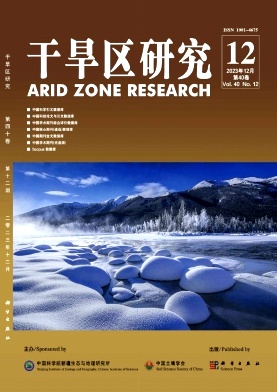Analysis on Interspecific Relationship of the Dominant Plant Species in the Ebinur Lake Wetland Nature Reserve, Xinjiang: Analysis on Interspecific Relationship of the Dominant Plant Species in the Ebinur Lake Wetland Nature Reserve, Xinjiang
Q3 Environmental Science
引用次数: 9
Abstract
According to the classification of the typical plant communities in the Ebinur Lake Wetland Nature Reserve,45 sample plots of 10 m×10 m were delimited around the reserve at the Dongdaqiao and Yaziwan management stations to record the quantitative community features including the species,abundance,height,stem diameter and crown diameter as well as the elevation,latitude,longitude,circumstance,geographical features and terrain of each sample plot during the period from June to September 2007.The χ2-test,contingency table,VR,Ochiai association index,Pearson's correlation coefficient and Spearman's correlation coefficient are used to study the interspecific relationships among the 25 main species in the typical communities in the Ebinur Lake Wetland Nature Reserve.The results are as follows:(1) The species of vegetation in the typical communities in the reserve are mainly composed of the families of Salicaceae,Tamaricaceae,Gramineae,Chenopodiaceae and Fabaceae,the species composition is poor,and 28 species samples were collected in the sample plots.The important value of Populus euphratica is the highest,and then it is followed by Halostachys caspica,Halocnemum strobilaceum,Aeluropus pungens and Glycyrrhiza uralensis.P.euphratica is the primary species in the study area and also the dominant one of the arbor layer,while H.strobilaceum,A.pungens and G.uralensis are separately the dominant plants of the shrub layer and herbage layer;(2) The total associations among all the species in the Ebinur Lake Wetland Nature Reserve are unremarkable negatively significant,and the unremarkable couples of species account for the highest proportion;the plant communities tend to grow independently.The results of χ2-test with contingency table also reveal that the associations between most of the pairs in the communities are remotely related,if so,the pairs of positive association will overweigh negative one,which shows that there is more mutual contribution among the associated species,and one's existence benefits another although the effect is unremarkable.There are more remarkably relative coefficients among the herbages,such as A.pungens,G.uralensis,Asparagus persicus,Alhagi sparsifolia and the other species than that of the arbors and shrubs,such as Tamarix ramosissima,H.strobilaceum,Reaumuria soogarica,Haloxylon ammodendron,P.euphratica,etc.The fact that the herbages are widely distributed over the investigated area indicates that these plants have a higher level of maturity and coexist with other species.The arbors and shrubs are comparatively more competitive than other species in making use of special resources.Based on the study of affinity in the Ebinur Lake Wetland Nature Reserve,Spearman's correlation coefficient is more sensitive to the affinity among species and higher compared with Pearson's correlation coefficient.Ochiai association indexes and the χ2-test with contingency table are consistent with each other;(3) Species with similar nature in the communities can be integrated as the biological groups,and they in the same group have more mutual associations and relativity and are in accordance with each other in adaptation to environment.According to the results of the Spearman's constellation diagram and χ2-test among the species,25 main species in the Ebinur Lake Wetland Nature Reserve can be divided into four biological groups.The first group is constituted by P.euphratica and H.persicum,P.euphratica is the constructive species and play a decisive role in this community,H.persicum is the co-constructive one.Both of them provide with a higher value of the dominance index.The second group is composed of A.pungens,T.ramosissima,Suaeda microphylla,Halimodendron halodendron,Cynanchum sibiricum and H.caspica.All the species in the second group are drought-enduring and infertile-enduring,and their choice to habits is very large.And the third group is composed of H.ammodendron,H.strobilaceum,Karelinia caspicas and R.soogarica,most of these species grow mainly on saline land of lake bank.新疆艾比湖湖湿地自然保护区优势植物种间关系分析——新疆艾比湖湖湿地自然保护区优势植物种间关系分析
在对艾比湖湖湿地自然保护区典型植物群落进行分类的基础上,于2007年6 - 9月在东大桥和鸭子湾管理站围绕保护区划分了45个样地,面积为10 m×10 m,记录了样地的物种、丰度、高度、茎径、冠径以及样地的高程、经纬度、环境、地理特征和地形等定量特征。采用χ2检验、列联表、VR、Ochiai关联指数、Pearson相关系数和Spearman相关系数对艾比湖湖湿地自然保护区典型群落25种主要物种的种间关系进行了研究。结果表明:(1)保护区典型群落的植被种类主要由水杨科、柽柳科、禾本科、藜科和豆科组成,物种组成较差,样地共采集到28种样品。胡杨的重要价值最高,其次是木耳树(Halostachys caspica)、褐花树(Halocnemum strobilaceum)、刺花树(Aeluropus pungens)和甘草(glycyrliensis uralensis),胡杨是研究区内的主要树种,也是乔木层的优势种;(2)艾比湖湖湿地自然保护区各物种间的总关联呈不显著负显著,不显著的物种对所占比例最高,植物群落倾向于独立生长。用列联表进行χ2检验的结果也显示,群落中大部分亲缘关系是远相关的,如果是,则正相关的亲缘关系大于负相关的亲缘关系,说明亲缘物种之间的相互贡献更多,一个物种的存在使另一个物种受益,但影响不显著。有更多非常牧草之间的相关系数,如A.pungens, G。乌拉尔杉、芦笋、疏叶alhagi和其他种类的乔灌木,如柽柳、柽柳、柽柳等。梭梭、胡杨等。这些草本植物在调查区内分布广泛,表明这些植物具有较高的成熟度,并与其他物种共存。乔灌木在利用特殊资源方面具有较强的竞争力。通过对艾比湖湖湿地自然保护区亲和度的研究,Spearman相关系数对物种间亲和度更为敏感,且高于Pearson相关系数。Ochiai关联指数与列联表χ2检验结果一致;(3)群落中具有相似性质的物种可以作为生物类群进行整合,同一类群中的物种具有更多的相互关联和相关性,在适应环境方面具有一致性。根据物种间的Spearman星座图和χ2检验结果,艾比湖湿地自然保护区的25种主要物种可划分为4个生物类群。第一组由胡杨和桃香组成。胡杨是该群落的建设性树种,在该群落中起着决定性的作用。仙子属共构植物。两者的优势度指数都较高。第二组由黄曲霉属、黄曲霉属和黄曲霉属组成。第二类植物均具有耐旱、耐不育的特点,对生境的选择余地很大。第三类群由梭梭属植物、梭梭属植物组成。主要生长在湖岸的盐碱地上。
本文章由计算机程序翻译,如有差异,请以英文原文为准。
求助全文
约1分钟内获得全文
求助全文
来源期刊

干旱区研究
Environmental Science-Water Science and Technology
CiteScore
2.50
自引率
0.00%
发文量
4294
期刊介绍:
 求助内容:
求助内容: 应助结果提醒方式:
应助结果提醒方式:


